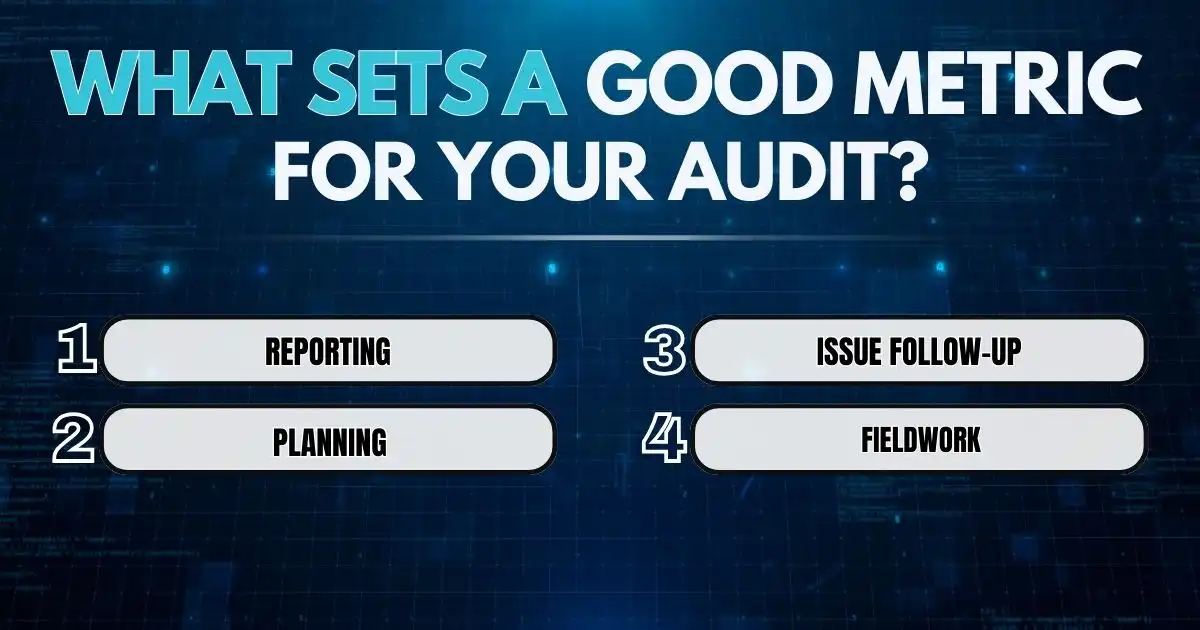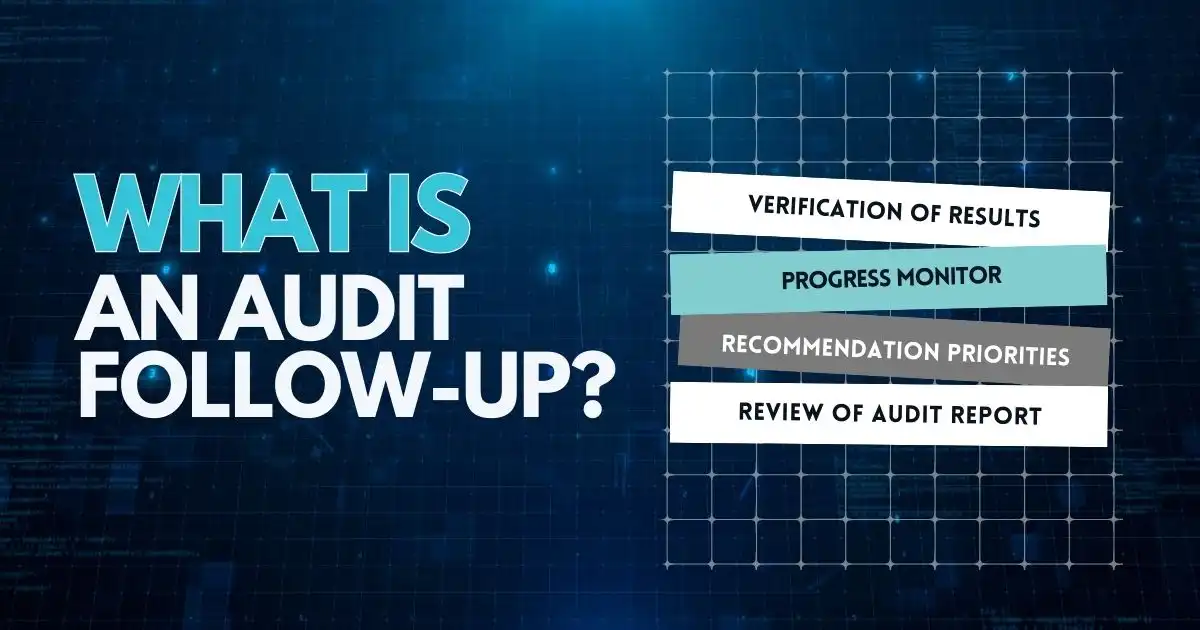Many auditors and business leaders look at reports and question whether their efforts are making a difference. Tracking an audit plan can be overwhelming, especially when results are unclear and goals seem distant.
This uncertainty can lead to doubts about the effectiveness of the audit process. However, understanding key performance indicators (KPIs) can provide clarity and turn frustration into progress.
What Sets a Good Metric for Your Audit?

Key performance indicators (KPIs) indicate how well a person, team, or company is achieving important goals. When goals are clear and we track the right KPIs, it shows that the internal audit team is contributing to the company’s overall success.
1. Reporting
- Final Report Issued Timely (set a target)
- Number of Issues Reported
- Number of Total Issues Identified
- Percentage of Issues Resolved by the Time the Final Report Was Issued.
- Number of Repeat Findings
- Number of Repeat Findings
- Number of Open High-Risk Issues
2. Planning
- Announcement Memo Was Sent on Time (X days before Fieldwork)
- The risks included in the audit match up with what the business wants to achieve.
- Percentage of Planned Audits Addressing High-Risk Areas
- Percentage of Risks Audited / Identified
- Planning Phase Completed on Schedule? (Y/N)
- Percentage of Audit Plan Completed
- Number of Unplanned Engagements
- The last time a process was audited
- Percentage Audits Completed on Schedule
- Customer Satisfaction Results
- Percentage of Surveys Returned
- Year After Year Score Analysis
3. Issue Follow-Up
- Issues Agreed Upon by Management?
- Issues Remediated by Due Date
- Number of Past Due Issues
- Number of Times Due Date is Changed
4. Fieldwork
- Compare planned fieldwork hours to actual hours spent.
- Weekly Update Check-ins Scheduled with Management
- How much fieldwork was completed on schedule?
How to Track Metrics in Your Audit Plan?
To track metrics in your audit plan, meet with managers each week to discuss any problems, the progress of the work, and the goals that have been reached. Try to complete your report soon after finishing your fieldwork, ideally within 30 days.
Also, review how many customer surveys were returned and whether their scores are improving each year. Finally, check what percentage of the risks you investigated aligns with your risk assessment.
Does Your Audit Plan Cover Key Risk Areas?

A solid audit plan involves more than just following rules like Sarbanes-Oxley (SOX). It looks at risks across the whole company.
Recommended Audit Projects for Cybersecurity
- Data Encryption
- Access Management Policies and Controls
- Data Penetration Testing with Vendors
- Business Continuity Plan (BCP)
- Patch Management Policies
- Employee Information Security Training
Culture and Ethics Audit Projects
- Digital Ethics
- How consumer information is managed and protected across the enterprise.
- Succession Planning
- Gender and Racial Discrimination
Recommended Audit Projects for Data Privacy
- General Data Protection Regulation (GDPR) Enforcement
- Consumer Consent
Data Governance Recommended Projects
- Data Quality
- Ways to ensure data is accurate and reliable when moving it, managing it during company purchases, and setting standards for its quality.
- Data Analytics
- Rules for using data analysis tools, keeping data safe and who owns it, and controlling who can access it.
Recommended Audit Projects for Third- Party Risk
- Background Checks
- Third-Party Risk Management
- Contract Management
- Right-to-audit Clauses
- Monitoring and Compliance
What is an Audit Follow-up?

Track progress using KPIs, then conduct follow-up audits to keep everything on track. Auditors decide the level of assurance to provide and allow time to fix issues.
During follow-ups, auditors remain neutral and verify that actions were taken. For high assurance, they conduct follow-ups as thoroughly as the initial audit. If resources are limited, they may perform a lighter review based on the original findings. In some cases, they simply report the organization’s progress without providing assurance.
1. Verification of Results
The last step is to check the results of the recommendations and see how effective and lasting they are. It’s advisable to collect and analyze data and evidence that demonstrate the achievement of the objectives and the improvement of the quality.
Compare the results to the starting point and standard measurements, and see how much the changes have made a difference and added value.
2. Progress Monitor
The third step is to monitor how well the team implements the suggestions and track the changes that occur. Create a schedule and set goals for each suggestion, ensuring everyone understands their responsibilities.
Inform those involved about the plan and expectations, and offer support as needed. Check-in often on how things are going and fix any problems that come up.
3. Recommendation Priorities
You need to decide which suggestions are most important, urgent, and doable. Think about the risks, advantages, and expenses of doing or not doing each one, as well as the time and resources you have.
Talk to the people who are affected, like managers, employees, or customers, to hear what they think. Then, rate each suggestion as high, medium, or low priority, and make a plan to deal with them.
4. Review of Audit Report
Carefully read the audit report first to understand what the suggestions are about and how they impact things. Be sure the report is clear, accurate, and easy to understand.
Look for proof and reasons behind the suggestions. If you notice any mistakes or things that don’t seem right, let the auditor or their team know. You can ask for explanations or corrections before agreeing to the report if needed.
Grow Your Audit Success with KPIs
Key performance indicators (KPIs) act like a compass for your audit plan, steering you toward success. By monitoring these important measures, you can assess how well your audit is doing and identify where changes are needed.
Just as a gardener nurtures their plants to help them grow, regularly reviewing KPIs allows your audit process to thrive. Paying attention to these indicators ensures that your audit stays aligned with the organization’s goals, supporting its long-term success.
FAQs
What is KPI in Audit?
In an audit, the internal audit team uses KPIs, or Key Performance Indicators, as specific measurements to assess their performance. These indicators demonstrate whether the audit meets its goals and supports the company’s objectives.
What is the KPI for Tracking Performance?
A KPI for tracking performance is a measurable value that shows how effectively an individual, team, or organization is achieving key goals. It helps identify areas of success and areas that need improvement.
What are the KPIs for Measuring Progress?
Specific metrics track progress toward achieving goals through KPIs. They provide clear insights into whether things are on track or need adjustment.
What are the 4 Key Performance Indicators?
The four key performance indicators (KPIs) are important for businesses. Revenue Growth measures income increases, while Profit Margin shows the percentage of revenue that becomes profit. Customer Satisfaction gauges customer happiness, and Operational Efficiency assesses resource use.
